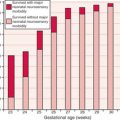CHAPTER 8 Thermoregulation
Background
While there are good data showing that the long-term management of preterm babies in suboptimal environmental temperatures is associated with poorer survival, and there are data showing an association between low admission body temperature and poorer survival, there are no data which show that admission hypothermia and the subsequent short-term hypothermia that occurs in the intensive care unit are causative of that poorer outcome. Admission hypothermia could simply be a marker for sicker infants who have already required more than usual intervention and who will have poorer outcomes. It cannot be assumed that making babies warmer at admission will improve their survival — more research is needed to determine a causal link between transient hypothermia and poor outcome, and whether improving admission temperatures is an effective intervention.




